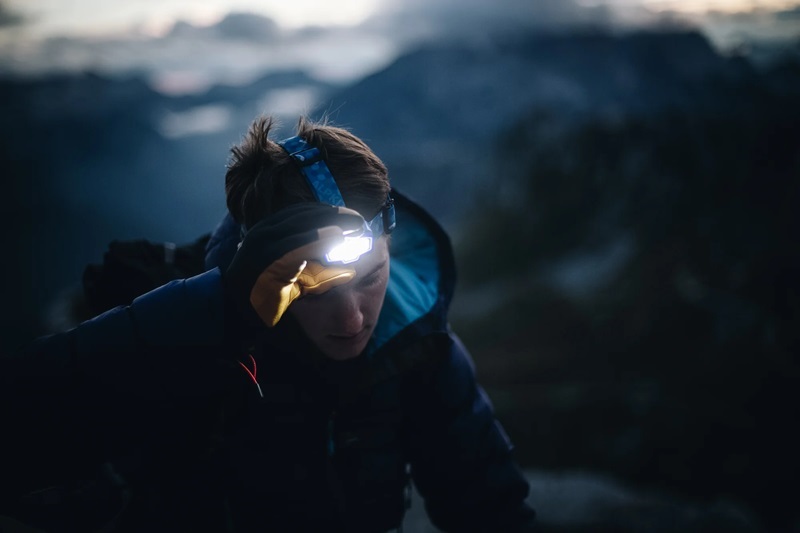Any time of the day is perfect for hiking for outdoor enthusiasts. However, while we usually plan our night hikes and have the right gear, we can’t predict the delays in our daytime adventures that can force us to hike back in the dark. That’s why we should be prepared anytime and always pack a suitable light. Headlamps are becoming the favourite choice for many campers, hikers and runners, and for a good reason. Here’s why you need a head torch, and everything you need to know to choose the right one.
Why Do I Need a Headlamp?

As you can tell from its name, a headlamp is a type of light placed on a user’s head. When you browse for a convenient head torch for sale, you’ll notice that most options come with advanced features, are easy to use hands-free and versatile, making them ideal for hiking and backpacking.
Hands-free Use
Trails can be challenging to manage at night: tree roots, twigs, rocks, and even animals are some of the many obstacles that can harm you. That’s why it’s very convenient to have your hands free while hiking – to catch yourself, move obstacles, run or fight off an animal – or for whatever Mother Nature throws your way. Head torches allow you to use your hands, eliminating the need to hold a light source, such as a traditional flashlight.
Lightweight and Easy to Use
Most light sources are hefty and bulky, especially the more powerful ones. Headlamps are portable and user-friendly, and because they rarely fall or come off when jogging, they’re safer to use. Weight and space are vital when backpacking, especially since having a successful adventure requires fitting as many devices in the bag as possible. When you search for a convenient head torch for sale, you’ll come upon options that are small enough to fit into even the smallest camping bags.
Versatile
Just because it’s a head torch, it doesn’t mean you can’t use it otherwise; you can use it as a flashlight in extreme situations so you don’t compromise visibility.
Convenient
Your handheld flashlight’s light source won’t likely align with your focal point. You can even have your flashlight move with the natural rhythm of your head and eyes when you walk by bouncing or swinging your hand while holding it, but the result would be a distracting illumination. A light source that will allow you to see where you’re going during night treks is critical.
Headlamps can improve your ability to concentrate on the current work. There will always be lighting in the direction of your vision because the light is attached to your head. It may seem absurd, but if you have to carry a flashlight for a long trip, your arm will eventually tire. Additionally, hand-eye coordination is a factor.
What Should I Look For When Buying a Head Torch?

The most important factors when buying a head LED torch are brightness, battery life, weight and cost. However, you must also consider the activity you’ll use the head flashlight for and factors like comfort, durability and functionality, as the brightest and most expensive option might not be ideal.
Brightness
The amount of visible light that can be detected by the human eye is called brightness, and it’s expressed in lumens (lm). Typically, torches range in length from 6 to well over 1000 lm. Several factors impact how bright you need your headlamp to be.
Your Activity
A head torch should be brighter the faster you’re moving. The brightness levels of most torches vary. Additionally, some are equipped with a red-light feature on the front that helps you keep your night vision, which is helpful while camping. In addition, there are other factors to consider, like the colour and temperature of the light. A whiter light, like that seen in kitchens, is more likely to keep you awake, whereas yellow light is more conducive to sleep.
Activity recommendations:
- Reading in the tent: 20 lumens (yellow light recommended)
- Trekking and backpacking: 200 lumens
- Urban jogging: 200 lumens
- Running on trails: 300–900 lumens
- Mountain running: 500–900 lumens is what mountain running uses. (white light recommended)
- Cycling: 900+ lumens
Ambient Light
The ambient light is another factor when deciding how bright a torch is needed. Powerful head torches are substantially less necessary for urban streets than a challenging rural trail. Being seen is usually equally as crucial as being able to see in urban environments. Consequently, purchasing reflective apparel and a rear red light is equally important as spending on a high-quality torch.
Battery Life
Your activity level will determine how long you need your battery to endure. The brightness level and battery size will determine how long the battery lasts. Since all batteries eventually run out, the brightness will be noticeably less after a few hours than when you first turned it on. Always use a rechargeable torch to lessen that decay and show environmental consciousness. Long-term cost savings, improved efficiency in the cold, and consistently higher output are all guaranteed.
Durability
Head torches often suffer a great deal! They are intended to be dependable even though they are dumped in the bottom of a backpack and used in bitter cold and rain. It’s best to look for a headlamp with a respectable IP (ingress protection) rating because you’ll need one when you least expect it. It must have an IPX4 rating, indicating it can withstand any weather. Additionally, every head torch must have a travel lock feature to prevent it from inadvertently turning on inside your luggage, which doesn’t pose a fire hazard but is frustrating when you need to use it.
Comfort
Head torches heavier than 200 gr are heavy and inconvenient. Cyclists often use a much heavier torch because of the battery, but they can mount it to their bike. Everyone else wearing their flashlight on their heads must use lightweight options for comfort and stability.
